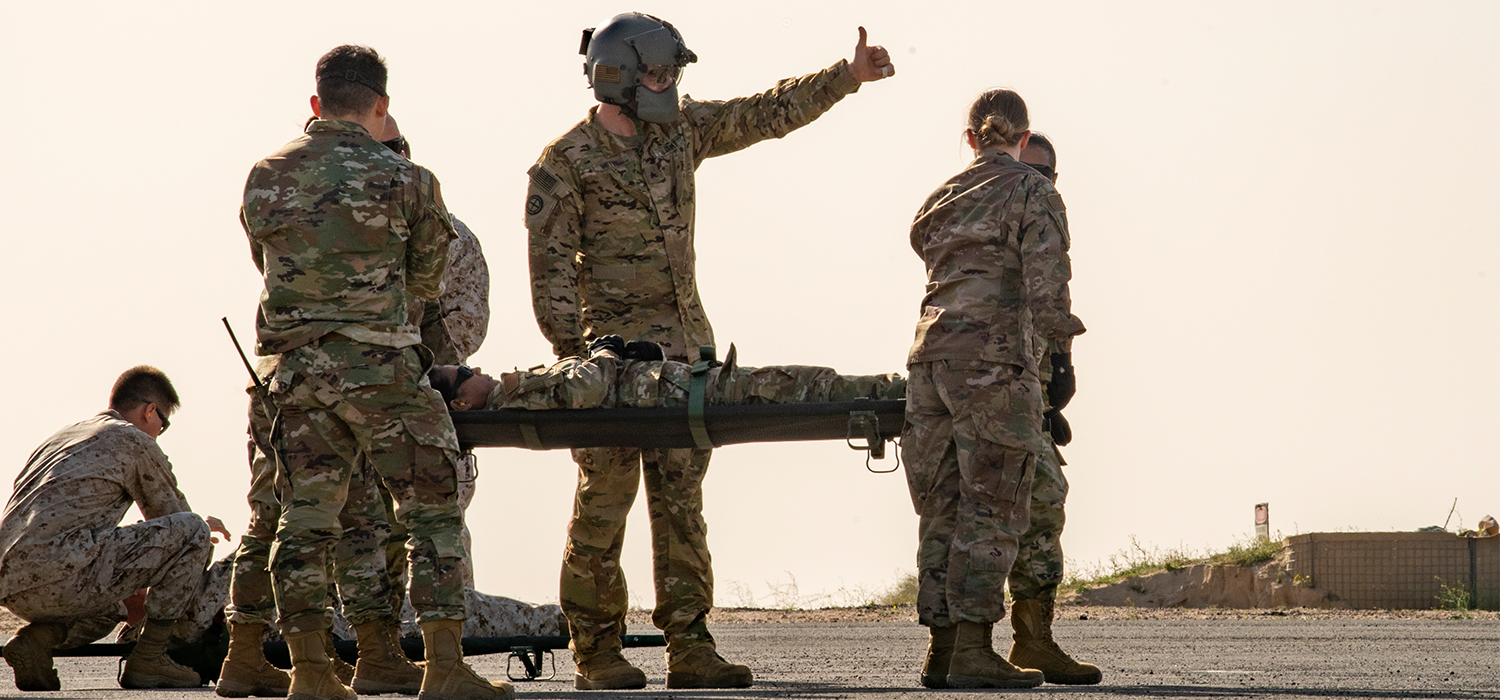Contributors: Keith Boring, Phillip Trezza, RACR and Carl Vickers
Hiring in healthcare is difficult. Finding a person with all the right qualifications plus the professionalism skills that elevate performance is no easy task for employers. However, there’s a large pool of potential candidates who have been trained in a way that instills a strong work ethic, cultural competence, and the leadership experience employers desire. Unfortunately,
this group’s training program is not well-understood, often leaving them overlooked.
Military service members annually represent approximately 250,000 candidates transitioning from active duty to civilian life.1 Those who have gone through different forms of specialized healthcare training are more than qualified to do many jobs in healthcare. In fact, military occupational specialty (MOS) training programs have inspired private sector training programs that often try to mimic their level of intensity.
The Medical Education and Training Campus (METC) is a U.S. Department of Defense (DoD) integrated campus that provides nearly 50 healthcare-related programs of study for military enlisted students. Located in San Antonio, Texas, its state-of-the-art facilities make up the largest allied health training center in the world.
Phillip Trezza, RACR, program coordinator for the Military Medics and Corpsmen Program (MMAC), Virginia Department of Veterans Services, believes the training that the DoD provides to medical service members is second to none. Trezza says, “What is most valuable about military medical training methodology is it instills an ability to work and deliver results in high-pressure and high-stress situations. For example, I had a new U.S. Army recruit ask me what my advice was so that he would be a good medic. My advice to him was to train until his skills became automatic, because when a situation gets hectic or dangerous, the ability to remain calm and trust the training is paramount. Expert training during high tempo and stress-induced situations is the ‘X’ factor that is rarely found in most civilian medical training.”
There’s no question that veterans who have completed military medical training have relevant training and experience, but because they don’t have the certification often required or preferred for allied health positions, they are faced with obstacles when transitioning to a civilian career. Without certification, it can be challenging for veterans to know where to start.
Navigating an unknown career path
Unfortunately, service members may not be aware of career paths in the private sector based on MOS. They often don’t understand how they can translate their extensive experience into a civilian career. Similarly, employers struggle to understand exactly how a MOS translates into a civilian healthcare role. Earning credentials can help solve this issue.
“While working with over 400 medically trained veterans that have applied to Virginia’s Military Medics and Corpsman Program, we can certainly attest to the fact that medically trained veterans are not leaving military service with credentialing comparable to the knowledge, skills and abilities they possess,” says Trezza. "That is exactly why Virginia’s legislature and Department of Veterans Services created the MMAC program.”
Trezza explains that most medics and corpsmen earn their National Registry EMT-Basic certification during their initial job training, but they typically do not receive the credentialing that reflects their abilities. This is complicated by the highly-regulated civilian healthcare landscape.
“Once they cross that imaginary line from military life to civilian life, their scope of practice does not come with them, as they have no verifiable credential that civilian healthcare hiring managers and healthcare regulators can approve and accept,” says Trezza.
GPS for credentialing
To help service members access credentialing, in 2002, the Army launched its Credentialing Opportunities On-Line (COOL) program. By 2014, all branches of the military had adopted the COOL program to assist their service members in earning credentials.
COOL helps service members find the most direct path toward earning credentials that align with their MOS. The program also provides specific directions for how to obtain the credentials. Service members can obtain a voucher that covers the cost of the credentialing exam, and from there, they take the exam, fully funded by the military.
Today, the Army, Navy, Air Force, and Marine Corps collaborate to share data, research, analysis, and best practices so that all service members can benefit from credentialing opportunities. All branches of the military recognize the important role that occupational credentials can play in professionalizing the force and enhancing service members’ abilities to transition to the civilian workforce after completing their military service.
When service members take advantage of the COOL program, they experience two main benefits: career advancement while they are enlisted and a smoother transition into civilian life.
Career advancement
The DoD believes that credentialing programs improve force readiness and professionalism. Service members are encouraged to take advantage of their branch’s COOL program early in their careers.
“The DoD supports civilian credentialing for active duty members because it improves the professionalism of our service members. In fact, if a credential is related to your military duties, completed academic degree, on/off duty training or civilian occupation (for Navy reservists), the services may pay for credential exams, applications fees, and annual maintenance fees,” says Keith Boring, director, Navy Credentialing Programs. “Service members can increase their effectiveness and improve their chances for promotion while on active duty, and at the same time better prepare for civilian employment when they do get out.”
Transitioning into civilian life
Earning credentials helps service members show that their skills are equivalent to skills of their civilian peers. In some cases, employment may mandate credentials, depending on state laws or employer requirements. Even when not required, credentials can result in a higher pay rate. The Bureau of Labor Statistics tracks earning statistics and consistently reports that people who hold a certification earn up to a 46% higher weekly salary.2
“A talent acquisition professional’s dream is to have a pool of military veterans that hold the combination of education, training and aligned credentials,” explains Carl Vickers,
Air Force veteran and military relations manager for People Scout. “When applying into the workforce, this is a recipe that makes candidates the most desirable and competitive in the employment market.”
With the desired (or sometimes required) certification(s), veterans with military medical training and experience can be attractive to healthcare hiring managers.
The value of veterans in healthcare
Although healthcare jobs are in high demand, working in healthcare is undoubtedly challenging. Between increasing patient-care demands and a heavy administrative burden, healthcare professionals need to be equipped with knowledge and experience to handle problems as they arise, and tend to them with a high level of detail. This level of responsibility for any one professional may be overwhelming; for many veterans, though, responsibility comes not as a burden, but as an opportunity.
“To a veteran, responsibility is empowerment. Veterans want to be empowered to do things. To change things. To make things better.
“Responsibility provides meaning. Responsibility provides purpose,” states Trezza. “To a veteran, responsibility is empowerment. Veterans want to be empowered to do things. To change things. To make things better. To ask questions and to see if things can be done more efficiently and effectively. These qualities, coupled with a deep sense of attention to detail, could very well be a driving factor of whether a healthcare system is profitable amidst increasing changes in Centers for Medicare and Medicaid Services (CMS)billing and reimbursement.”
As veterans work to transition to civilian life and translate their experience, training and skills to a career outside of the military, the COOL program gives them the ability to acquire nationally-recognized certifications that can help them secure civilian employment. Healthcare credentials can help empower them to find not just a job, but a career that’s relevant to the service they’ve provided to their country. This not only has the power to help improve their quality of civilian life, but also to help fill in-demand healthcare jobs and, ultimately, to deliver high-quality care to the patients they serve after they leave the service.
References
1Dupree A. (2018, August 28). The transition from a military to civilian career just got easier. Retrieved March 26, 2019 from https://www.careerbuilder.com/advice/transition-from-military-to-civilian-career.
2 The Bureau of Labor Statistics. Household Data: Annual Average. (2018). Retrieved March 26, 2019 from https://www.bls.gov/cps/cpsaat55.pdf.




